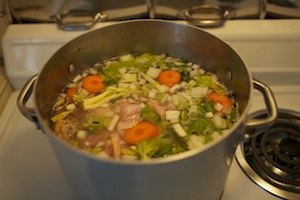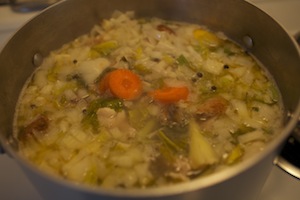Springtime can bring surprises. New Englanders really appreciate the first few days of sixty-degree temperatures, particularly after a long, hard winter. You can imagine that it’s incredibly frustrating to be sick at home with a nasty cold or flu on the first, warm sunny days of springtime, when it sounds like the whole world is waking up outside and you’re stuck in bed. When I really want to be cruising down the street on my motorcycle, instead I’m fitfully snoozing under the covers, with crumpled tissues strewn about.
However, I have a secret weapon that is so stupidly simple to make that even someone sick at home should have little problem to throw together in about ten minutes.
It’s chicken soup. Lovingly referred to my many as “Jewish Penicillin,” for ages people have known that eating homemade chicken soup is a good thing when you’re sick. There are studies that show that chicken soup can be a help, and obviously it’s nutritive. Heck, even back from my medical school days I remember some random fact about chicken soup being “osmotically correct,” meaning that it’s close to the same osmotic concentration as your own. This is important, as chicken soup does a tremendous job of helping rehydrate you, which is what you really need when you’re sick.
People often ask me for a recipe for chicken soup. Like a lot of cooking, I’m happy to say that it isn’t rocket science, and you don’t need to buy cans of crappy, over-salted canned soup that won’t hydrate you as well (or taste as good) as the homemade stuff. This is a throw-it-together in the pot sort-of-thing (believe me when I say that you really don’t want to be worried about exact proportions when you’re sick), and you’re back in bed in a flash while the soup or stock slowly simmers away on the stove.
Like most dishes, I want readers to focus on the techniques involved, as opposed to focusing on the recipes themselves. The word of the day is SIMMER. I’ll get to that in a minute. If you forget everything else in this article, I just want you to remember the word SIMMER. That’s important.
How do I myself make chicken soup (or stock?) Here’s the general idea. I throw the following items into a pot:
- One whole chicken cut up into pieces (or largely bones, if I’m just making stock)
- Mirepoix (This is French for chopped carrot, celery, and twice as much onion. How much? Maybe a carrot, one or two celery stalks, plus one large onion.)
- Parsley (particularly the stems)
- A small handful of peppercorns
- Possibly a few bay leaves
- Possibly a lemon wedge
I fill the pot with water, I cover it, and bring it to heat no higher than a SIMMER, and let it go for at least two hours. For chicken soup, I’ll serve the strained broth with the meat. For stock, I’ll pitch everything except the strained broth. Season with salt and pepper to taste.
What’s the big deal about SIMMERING? The key here is to bring the temperature of the soup/stock where small bubbles come up to the surface. At this point the temperature should be

Mirepoix: 50% onion, 25% carrot, 25% celery. A rough chop is just fine for this application.
somewhere between 180F-200F or so. The key thing is that you don’t want to ever let it get it up to a rapid boil (212F), or the soup/stock will turn cloudy, and it will look pretty unappetizing.

Okay, some of you are already raising your hands with questions. Here we go:
- What about egg noodles? Take the amount of soup/stock that you want to eat, and put that into a smaller, separate pot. For that, it’s now okay to bring that to a BOIL and toss in a handful of egg noodles. Stir and boil the noodles for as long as specified on the box. No need to strain. Just eat it when it’s not mouth-burningly hot..
- You’re probably at home and are sick, so keep it simple. Don’t bother peeling the carrot or celery. Just make sure your veggies are clean, do a rough chop, and you’re good. As for the onion, just make sure it’s peeled and again, do a rough chop, and toss it into the pot. What about those celery leaves? Throw it into the pot.
- Remember: A stockpot is not a “garbage can.” Don’t just throw every scrap in there and think your soup or stock will come out tasting right.
- What about the scum and liquefied fat that rises to the top? Again, if you’re home sick, don’t worry about it. If you have time, periodically skim it off. (This skimming process is known as “depouillage.” You’re home sick. Skip it. Stay in bed. Let it do it’s thing.
- If you’re shooting for stock, you’re more concerned about cooking the bones as opposed to cooking both meat and bones together (which is soup). It’s your call.
- Whenever I roast a chicken, I save all the bones, cartilage, leftover meat bits, and even the fat – and put into a zip-top bag in the freezer. When I want to make stock, I have it on-hand and throw it in a pot and make stock. Waste not, want not.
- Chicken stock? I always keep a pint in the freezer in a “crabbo” (a plastic one-pint take-out containter) on hand, for deglazing a pan, to make a quick pan sauce, to make gravy, to bang out some last-minute risotto, or to even just enjoy as a quick cup of soup (if I throw some chicken meat in it).
- If you bought a whole chicken, use the neck. However, don’t throw the liver and gizzard into the soup/stock. It’ll give it an off-flavor.
- What’s with the photos of the deboned chicken pieces? I bought a whole, naturally raised chicken (think the good organic stuff; it’s not only better for the environment but it simply tastes better), quickly deboned and deskinned the breasts, including the leg/thigh quarters as single pieces. The chicken went into a zip-top bag, and I tossed it in the freezer for another night’s dinner. Everything else went right into the pot. (Two dinners in one!)
- Made a roast chicken for dinner. Save and freeze the bones for the next time you want to make chicken stock. (For me, I seem to make chicken stock every six weeks or so, and more so during the wintertime.)
Again, chicken soup or chicken stock isn’t rocket science. It’s the ultimate “dump-and-stir” thing, which is what you really want and need when you’re sick.

Debone a whole chicken, freeze the meat, and save it for another night’s dinner. Throw the rest in the pot.
So remember: Keep it to a SIMMER (not a boil), keep hydrated with soup and lots of fluids, take two aspirin, and call me in the morning.


